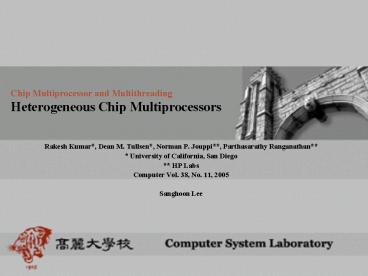Chip Multiprocessor and Multithreading Heterogeneous Chip Multiprocessors - PowerPoint PPT Presentation
1 / 13
Title:
Chip Multiprocessor and Multithreading Heterogeneous Chip Multiprocessors
Description:
... consumption and Heat dissipation. Increased power consumption ... To maximize the ratio of performance to power dissipation. During serial portions of execution ... – PowerPoint PPT presentation
Number of Views:241
Avg rating:3.0/5.0
Title: Chip Multiprocessor and Multithreading Heterogeneous Chip Multiprocessors
1
Chip Multiprocessor and MultithreadingHeterogeneo
us Chip Multiprocessors
- Rakesh Kumar, Dean M. Tullsen, Norman P.
Jouppi, Parthasarathy Ranganathan - University of California, San Diego
- HP Labs
- Computer Vol. 38, No. 11, 2005
- Sanghoon Lee
2
Contents
- Performance Scaling and Technology Challenges
- What is the Chip Multiprocessor (CMP)?
- A Critical Question in CPMs
- Heterogeneitys Potential
- CMPs Power Advantages
- CMPs Throughput Advantages
- CMPs Mitigating Amdahls Law
- What Heterogeneity Means for Software?
- Future Research Questions
- Conclusion
3
Performance Scaling and Technology Challenges
The TRIPS(The Tera-op, Reliable, Intelligently
adaptive Processing System) Project The
University of Texas at Austin, http//www.cs.utexa
s.edu/trips
4
What is the Chip Multiprocessor (CMP)?
5
A Critical Question in CPMs
- Amdahls Law
- The performance improvement to be gained from
using some faster mode of execution is limited by
the fraction of the time the faster mode can be
used. - Critical Question Size Performance
- Characteristics of applications are different
from each other. - How should designers choose between these
conflicting requirements in core complexity? - A large number of small cores
- A smaller number of larger, higher-power cores
Heterogeneous Chip Multiprocessor
6
Heterogeneous Chip Multiprocessor
- Heterogeneous Multicore Architectures
- System-on-chip
- Multi-ISA multicore architecture
- Single-ISA multicore architecture
- Heterogeneous Multicore Design
- Conjoined-core chip multiprocessing
- CMP/interconnect codesign
Original core
Conjoined-core pair
7
Heterogeneitys Potential
8
Power Advantages
- Power consumption and Heat dissipation
- Increased power consumption and heat dissipation
- Higher costs for temperature management
- Currently used two techniques for power reduction
- Gating-based
- Voltage/frequency-scaling-based
- However, any technique applied at a single-core
level suffers from limitations - Leakage power
- Some dynamic power is still dissipated even for
inactive blocks - Heterogeneous CMP has the ability to
- dynamically switch between cores
- power down unused cores to eliminate leakage
- Reductions in processor energy delay product
- 84 for individual applications
- 63 overall
9
Throughput Advantages
- Two reasons for performance advantages
- Heterogeneous CMP can match each application to
the core best suited to meet its performance
demands - Heterogeneous CMP can provide improved
area-efficient coverage of the entire spectrum of
workload demands seen in a real machine.
Performance of heuristics for equal-area
heterogeneous architectures wit multithreaded
cores.
10
Mitigating Amdahls Law
- The speedup of a parallel application is limited
by the fraction of the application that is
serial. - To maximize the ratio of performance to power
dissipation - During serial portions of execution
- use a single large core to allow the serial
portion - During parallel portions of execution
- use a large number of small area- and
power-efficient cores
11
What Heterogeneity Means for Software?
- The system software must use the execution
characteristics of each application to predict
its future processing needs and then schedule it
to a core that matches those needs if one is
available. - OS
- Compiler
- Programming or compiling parallel applications
might require more awareness of the heterogeneity
. - Mechanisms for communicating the complete
processor information to software - Mechanisms for the design of software to tolerate
heterogeneity - To support for virtualization
12
Future Research Questions
- Designs of asymmetric CMP cores
- The number of core types
- the available die area
- the total power budget
- What benefits are possible if all the resources
in the cores are not monotonically increasing? - The impact of heterogeneity on the cost of design
and verification
13
Conclusion
- Monolithic processors
- consume too much power.
- do not provide enough marginal performance.
- Replicating monolithic processors
- results in a linear increase in power.
- results in a sublinear increase in performance
- cannot handle high-demand and high-priority
applications. - Single-ISA heterogeneous (or asymmetric)
multicore architectures - result in significant power and performance
benefits. - The potential benefits are greater than the
potential benefits from the individual techniques
of voltage scaling, clock gating, or speculation
control. - Much research remains on the best types and
degrees of heterogeneous CMPs for both throughput
and power.































